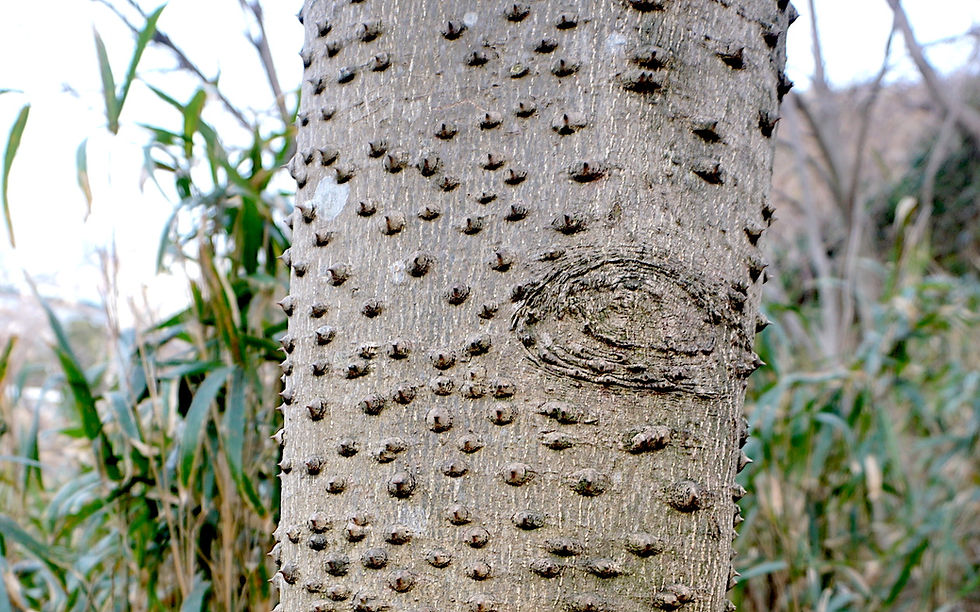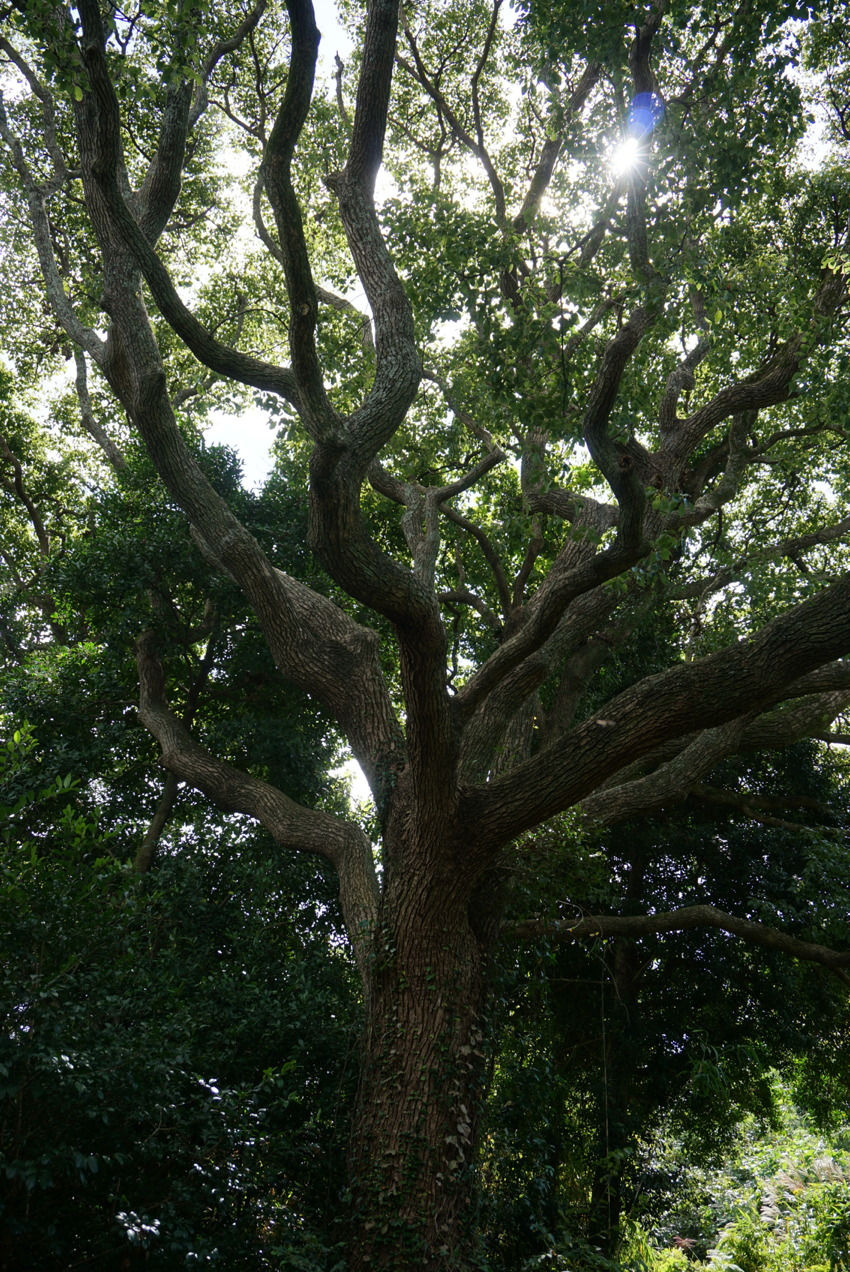愛宕の森と緑を守る会
Atago Mountain Plants-Trees 2
(Click the image to enlarge it and see the full description)
Trees and other pages (flowers are on pages 1 to 3 according to the season). Images of trees with flowers and fruits are also displayed by season. The species names are listed in order of Aiueo on the left side. Click to move to the location where the image was displayed.






隠蓑。ウコギ科カクレミノ属の常緑亜高木。別名、カラミツデ、テングノウチワなど。暖地の沿岸部に生える。成長につれ下の葉を落とし、葉形も変化する。日陰に強く、園芸樹木として利用される。

構苺、あるいは梶苺。バラ科キイチゴ属の半常緑低木。高さ2~3m。別名エドイチゴ、オオモミジイチゴ。花期は4~5月。果実は5〜6月頃橙黄色に熟し、食べられる。モミジイチゴなどとの交雑種が多い。

紙八手。ウコギ科カミヤツデ属の常緑低木。別名、ツウソウ(通草)、ツウダツボク(通脱木)。台湾、中国南部原産。葉は大型でヤツデに似るが、光沢がない。茎の髄を紙(通草紙)にし、色紙、造花などに用いたが、現在は需要がない。観葉植物としても需要があったが、西日本の暖地の海岸付近で野生化して広まり、生態系の破壊が危惧されている。

烏山椒。ミカン科サンショウ属の落葉樹で、アゲハ類の食樹としての役割が大きい。蜜源植物で清涼感のある蜂蜜がとれる。裸地にいち早く進出する先駆植物。紅紫色の果実が熟すと、3mmほどの黒い種子が表れる。鳥が好み、被食散布で分布が広がる。

カラスザンショウの幹。樹皮は灰色で、幹や枝に多数の丈夫な棘がある。棘の先端はかなり鋭い。

枳殻。ミカン科カラタチ属の落葉低木。別名、キコク。原産地は長江上流域で、8世紀頃には日本に伝わっていた渡来植物。「唐橘(からたちばな)」が名前の由来に。未熟果は健胃薬に用いられる。

愛宕神社の境内、本殿脇に植えられている。花期は4〜5月。10〜11月に実が黄色く色付く。花、実、共に芳香がある。鋭く丈夫な棘があるので、生け垣や畑の周りに植えられていたが、現在はあまり見かけない。北原白秋作詞の唱歌「からたちの花」を始め、唄の題材にされることが多い。

愛宕山の北側斜面、愛宕山観光道路脇に2本のカワヅザクラ(河津桜)が植えられている。(2016.03.05撮影)

カワヅザクラはソメイヨシノに先駆けて濃いめのピンクの花を開く。


寒緋桜。バラ科サクラ属。別名でヒカンザクラとも言う。早咲きで、3月始めから釣鐘状で濃いピンクの花が咲く。沖縄でサクラといえばこれを指す。サクラの原種の一つ。園芸種の元に用いられ、カワヅザクラはこれとオオシマザクラとの自然交配種。

愛宕山では北側の麓、住宅展示場の近くと、愛宕神社境内から一段下がった場所との2カ所に生えている。花びらは散らずに、萼ごと落下する。

木蔦。ウコギ科キヅタ属。常緑つる性で、冬でも葉があるのでフユヅタ(冬蔦)ともいわれる。オニヅタという別名もある。若いキヅタの葉は3~5つに分かれ、古いキヅタの葉はタマゴ形。葉柄や葉の両面とも無毛。よく似たセイヨウキヅタ(アイビー)は葉柄や葉の裏面に白くて長い毛があり、区別できる。

キヅタの幹。気根を出しながら、他の樹や岩を這い上がり、覆い尽くす。

夾竹桃。キョウチクトウ科キョウチクトウ属。街中で普通に見かける常緑小高木。インド原産で、江戸時代中期に中国から伝わった園芸種だが、めったに結実しないため自然に広がることはほとんどない。

排気ガスや乾燥に強いため街路樹によく用いられ、夏にピンクや白い花を咲かせる。

キョウチクトウは非常に強い毒性がある樹なので要注意。串や箸として用いたり、切った木を燃やした煙を吸うだけで中毒症状に。含まれ�る毒性成分のうちのオレアンドリンは青酸カリより強毒。強心作用、利尿作用があるため薬草として用いられるが取扱注意とされている。

桐。キリ科キリ属の広葉落葉樹。英名princess tree。以前はゴマノハグサ科、あるいはノウゼンカズラ科に分類されていた。原産は中国で、飛鳥時代に渡来したといわれていて(不明との説もある)、栽培で広がり、野生化している。蕾ができてから9ヶ月後の��4〜5月に、釣鐘状で淡紫色の花が枝の先端で房状に咲く。アオギリは全く別種(アオイ科)。伝説の鳥、鳳凰はキリの木のみに止まるとされ、高貴な木のイメージがある。日本国政府の紋章としても使われ、パスポートや五百円硬貨のデザインにもなっている。

キリの果実は4cmほどで硬く、中にはフリル状の羽の付いた種子が大量に入っている。冬から春にかけて果実が2つに裂け、そこから種子が徐々に風で飛ばされていく。 キリは成長が早く、10数年で用材として使える。軽くて木目が美しいだけでなく、防湿、抗菌、保温、難燃性、腐食に強い、狂いが少ないなどの優れた特徴があり、桐箪笥などの高級家具、あるいは下駄や箱などの日用品としても用いられている。昔は女の子が産まれるとキリの苗を植え、それで嫁入り道具を作るという風習があった。樹皮は染料に、葉は除虫に用られた。

枸杞。ナス科クコ属の落葉低木。東アジア原産で、別名ゴジベリー。夏に薄紫色の花をつけ、秋には赤い果実をつける。クコの実は食用や果実酒、薬膳、薬用植物として人気がある。実だけでなく、葉や根皮も滋養強壮の効があり漢方で広く用いられている。匍匐茎を伸ばして広がり、挿し木も容易にできる。

草苺。バラ科キイチゴ属の落葉小低��木。花期は3~4月で白い花は良く目立つ。高さが20~40センチと低いため、草と見間違えられ、名称の由来に。

初夏に稔る赤い果実は酸味が少なく甘くて美味しい。食べるには、鳥との競争に。

臭木。シソ科クサギ属の落葉小高木で、全国に分布している。別名、クサギナ、クサギリ、トーノキ、トリバ、 臭梧桐など、多くの地方名がある。かつてはクマツヅラ科に分類されていた。 葉や茎を傷つけると異臭(ビタミンB剤の臭い?)がするのでこの名に。 藪で最初に侵入する典型的な先駆植物で、害虫が付きにくく、砂防地での緑化樹木としても用いられる。

花期は8~9月。名前とは異なり、花は甘い香りがする。昼にはアゲハが、夜にはスズメガがよく集まる。雄しべは1日で萎れ、その後に雌しべが受粉可能になる。

花が終わると萼が紅紫色になり、星状に開く。中の果実は球形で、熟すと光沢のある藍色に。実は媒染剤無しで空色の草木染めに用いる。萼は渋い灰色の染料になる。

樟あるいは楠。クスノキ科ニッケイ属の常緑高木。台湾や中国から入ってきた史前帰化植物。関東南部以西から四国、九州で多く見られ、巨木になる。樟あるいは楠。クスノキ科ニッケイ属の常緑高木。台湾や中国から入ってきた史前帰化植物。関東南部以西から四国、九州で多く見られ、巨木になる。

クスノキの葉。木全体に香りがあるが、葉を揉むと特に強く香る。アボガドやシナモンと同類。新しい葉が出る時に古い葉が落葉する。防虫剤や医薬品として用いられる樟脳は枝葉を蒸留して作るが、現在は合成樟脳に代られている。

クスノキの幹。樹皮には深い縦の溝が入っている。

橡、櫟、椚、功刀など多数。ブナ科コナラ属の落葉高木。里山の雑木林でどんぐりのなる代表的な樹で、縄文の時代から食料(アク抜きが必要)や薪、木材として利用されてきた。樹液を求めて甲虫類や蝶、蜂などの昆虫が集まる。 クヌギの樹の根元に囲いを設置し、カブトムシの産卵床を作成した。

クヌギの葉はクリの葉によく似ているが、周囲にある棘(鋸歯)が白っぽい色をして長めなのが特徴で、緑色のクリと区別できる。画像は、自然教室でクヌギのドングリを埋め、育てる取り組みをおこなって育った若木。

栗。ブナ科クリ属。雌雄異花で5〜6月に開花。9〜10月にイガのある殻斗の中に2〜3個の実をつける。クリの樹は落ちているイガから2~3本と思われるが、今のところ、どの樹か同定でき�ていない。

実(堅実)は熟すと殻斗が裂け、姿を現す。野生種のクリはヤマグリ(山栗)あるいはシバグリ(柴栗)と言われ、栽培種のクリより実が小さい。愛宕山のクリは実が大きく、栽培種と思われる。

黒鉄黐。モチノキ科モチノキ属の常緑高木。雌雄異株。別名フクラシバ。4月頃に新芽が出ると古い葉が落ちる。葉は深緑色で表面につやがある。モチノキとの違いは、モチノキは枝(および葉柄)が黄緑色だが、クロガネモチは黒紫色。この色を鉄(くろがね)色とみて、名が付けられた。枝には鈍い稜がある。樹皮は鳥もちや染料に用いる。

雌株は(雄株なしで)秋に5mmほどの鮮やかな赤い実をつける。これが冬期の彩りになるので庭木として人気がある。

黒木。ハイノキ科ハイノキ属。南関東以西の海岸地域に分布する常緑樹。

クロキの花。花期は3〜4月で、香りの良い白い花をつける。密集している雄しべは長く黄色いため目立つ。秋になると実が熟して黒くなる。

葉はモチノキに類似するが、縁に浅い鋸歯があることで区別できる。若い枝には縦に4本の稜がみられ、断面が概ね菱形をしている。

愛宕山には、街路樹の他にはケヤキは数少ない。この樹も公園に植えられたもの。

小楢。別名ホウソ。ブナ目ブナ科コナラ属の落葉樹。雌雄同株。秋に紅葉して葉が茶色となるが、春に新たな葉が出るまで落葉しない。

コナラの幹。幹の色は灰色で、縦の裂け目が特徴的。

コナラの花。若葉とともに小枝の先端から多数の花が垂れ下がる。

駒繋。マメ科コマツナギ属の落葉小低木。高さは40〜80 cmほど。本州や九州の草地・土手・道端などの日当たりの良い場所で見られる。名前の由来は馬を繋ぎ止めたからという説と、葉が馬の大好物で馬を繋ぎ止めるからという説があるが、幹も枝もさほど太くないため、後者の説がもっともらしい。 この他に、低木〜小高木で高さ4mになる中国原産のキダチコマツナギやトウコマツナギがあり、日本各地の道路法面などで見られる。コマツナギに極めて似ているが、同一種との分類もみられる。

花期は7〜9月で、ハギに似た淡紅紫色の花が花序の下から咲いていく。花の全体はクズの花を小型にした姿となる。

ミツバウツギ科ゴンズイ属。落葉性の小高木。花期は5-6月。

新芽は茹でて食べられる。



イイギリ科クスドイゲ属。学名 Xylosma congestum。雌雄異株。近畿以西~東南アジアの海岸地域の林に分布する常緑亜高木。花期は8~9月。果実は5mm程度の球形で晩秋に熟し黒くなる。 大濠公園に大木が数本生えている。

この樹の最大の特徴は棘。幹や枝に大きく丈夫な鋭い棘が多数ある。近づきたくない木だ。
Paper mulberry

楮。あるいは梶の木(俗用)。イラクサ目クワ科コウゾ属。雌雄異株の落葉高木。原産地は中国中南部、台湾、東南アジア、インド等。別名、カジ(梶)、コウ(構)、穀。古代から神木とされ、神事の際に使われた。楮の葉は諏訪神社の神紋。家紋にも多く使われている。

樹皮は和紙の繊維原料として用いられ(画仙紙など)、学名の由来になっている。家畜飼料にもなったので、広く栽培されていた。花期は5~6月、果実は7~8月。橙赤色に熟すと食べられる。

若い枝の葉は3~5葉に分かれているが、成長した樹の葉は先の尖った卵形に。

「梶の木」は誤用だが、「楮」の訓読みが「カジ、カゾ、コゾノキ、コウゾ」などで、一般的には「こうぞ」なので混乱する。女坂の下の谷筋の道、突き当たり付近に見られる。












































